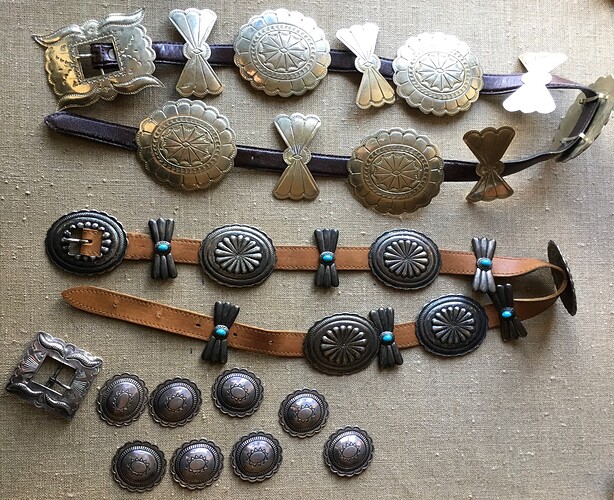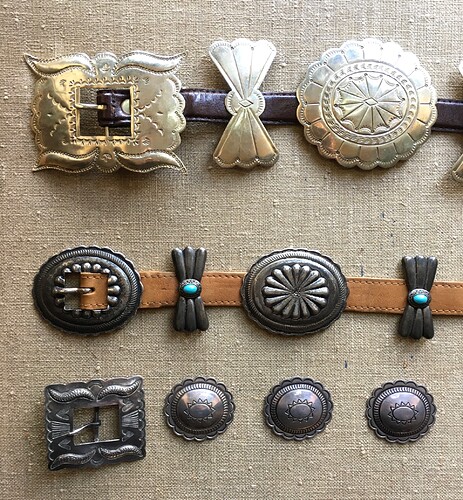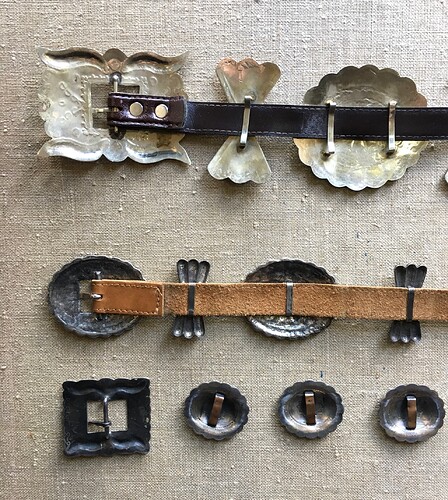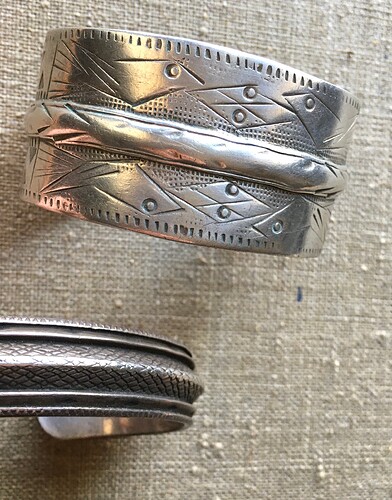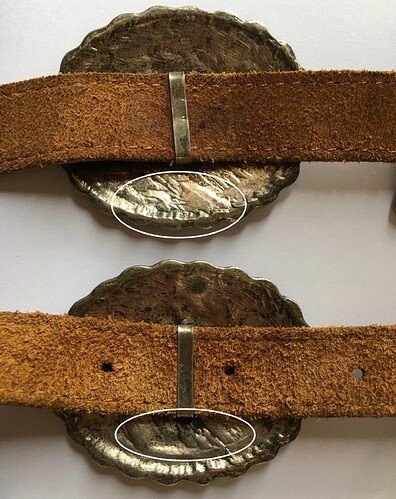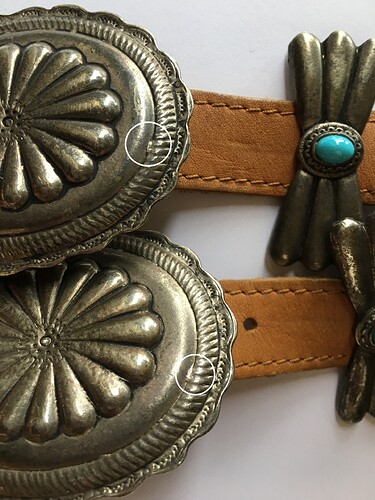This week i got very lucky and came into contact with a friendly gentleman who offered a great deal on some pieces that i really liked. Initially i bought 2 silver bracelets and then suddenly he also offered 3 concho belts and some beautiful necklaces. I’m very much a beginner and am trying to find any information i can about the pieces. The belts have no makers’ mark. I was told that all pieces are Navajo. My main interest is to try and date them. And if possible what type (of turquoise) the stones are. Any help would be greatly appreciated.
Hello and welcome! About the concho items: the scale is not clear enough to figure out if these are adult-size concho belts. How long is each strap? How wide is the leather strap? How big is each buckle? Have you tested the metals for silver content?
The top wider cuff is not Native American. It’s probably Berber/Morocco/North African. It’s very interesting and fun, central motif looks like birds. Did you check silver content? The other, smaller cuff with the hallmark of J Bond may refer to a company/individual who has been stated to be Native, but is not known to be Native. Everything about the smaller cuff is alien to Native American/Navajo work.
Necklaces: the right one has a Peyote Bird tag, meaning it’s from a Santa Fe jewelry company “inspired by the Southwest” and apparently sells both Native and non-Native work. Don’t count on this being Navajo, certainly. You could maybe write them and ask if they have more info.
The necklace on left has heishe that resembles NA handmade beads, but without info on its origin can be only a guess. Note that the findings on it (bead and clasp) are for sure Thai import.
Hi chicfarmer, thanks a lot for your detailed reply!
The leather belt on top is 39 inches long and 0,75 inches high. The conchas are 3,5 x 3 inch.
On the one in the middle the leather is 3 feet long and 0,75 inches high, the conchas are 2,5 x 2,25 inch.
The one on the bottom has conchas that measure 1,75 x 1,5 inch.
With the one on top i have a hard time figuring out the metal, i’m guessing some kind of nickel, but am not sure because the conchas appear to have been sawed manually. The silver acid test gives a greenish result.
The one in the middle appears to be silver but less pure than sterling (acid test gives very dark red brownish result). The one on the bottom is sterling i think (bright red test result).
I tested the stones with a q-tip and acetone and didn’t see any colour coming from the stones (for what it’s worth).
Interesting determination for the cuffs and the necklaces, your post already taught me a ton! Also with regards to terminology. The cuffs tested positive for sterling.
I should add that i am very happy with these items even though some turn out to be non-NA. They are a joy to wear plus they were very affordable (imo). I found them on a website that is like an online thriftstore.
@chicfarmer and @mmrogers will definitely give one a reality check which is very helpful. Nice pieces from the photos. That being said, even after 40 years I am still cautious when buying. I still like to see “sterling” stamped on pieces and check the stamps to make sure they are not all perfect. I could go on but there is enough info on this site for you to research. best wishes in your purchases.
Thank you sir! And i will definitely browse around plus enjoy all the beauty in the pictures in the process
I am not an expert on concho belts as a whole, but I probably like the one with the turquoise best at a quick glance. I can’t see it very well, but the stamping around the stones looks unusual to me. I don’t think I could make a guess on the turquoise, hard to tell. One thing you will learn on here is that figuring out which mines turquoise comes from, is pretty much guessing, although sometimes it can be educated guessing. Agree with Chicfarmer’s points about the cuffs and the necklaces, but they are still lovely.
I mostly agree with @StevesTrail, but not completely on the sterling. I have a lot of pieces that are older and do not have any sterling mark. But I am very, VERY careful where I shop, and to be honest, I seldom shop online.
Edit: I believe you said you’re from Holland, so I know that for you shopping online is probably a necessity. I would advise (besides learning as much as you can on this site) checking out the websites of really good stores that people on this forum have mentioned that they love.
Thanks for your response Ziacat. I really appreciate you guys taking the time to respond. Personally i’m the most happy with the small one (without a belt), because it’s sterling, which i love to wear, and because it will fit most of my pants. I’m having a belt attached to the buckle atm.
The one with the stones looks unusual to me as well. The hammering looks shallow for lack of a better description. And i’m still not sure what materials were used. Maybe copper that was dipped in silver or something. I might learn eventually along the way.
And being from Holland has it’s pros and cons i guess. I think over here people use terms like ‘Navajo’ and ‘turquoise’ a little more loose, it’s more exotic over here.
What’s nice is that there are quite a lot of beautiful things too be found and often very reasonably priced. And often people have bought pieces on holiday from the indians themselves in the 70s.
Welcome Bluegreen! Very nice pieces.I agree with Chicfamer with regard to both bracelets being non-native. The larger of the two employs stamps made in a native style, but the stamps themselves are fairly crudely made, and the work looks experimental to me.
The belts are very nice. The larger belt on top looks like it might be nickel, while the lower two appear to be silver (or possibly silver plated). It’s hard to tell from the photos alone, but to me it looks like the upper, and middle belts may be die struck, or mostly die struck, rather than handmade. Likewise with the smaller, lowermost belt.
Thank you mmrogers! Funnily enough i was just checking some bracelets that are near identical to the bigger one. And you guys have been spot on; they are mostly being attributed to Tunesian/ Berber artists. The stamped 7 seems to be a size indication.
And what you say about the belts answers one of my main questions about 'em. I had a hard time understanding why the conchas are so much more ‘perfect’ than the buckles. So that’s because of die struck. I’ll investigate that later tonight, very interesting.
I also took some better close ups of the belt with the stones. With the other 2 belts i can ‘read’ what the craftsman has done, i.e. hammered designs here, sawed out the contours there, etc. But i have a hard time following the work that was done on the belt with the stones. Furthermore it has some kind of smelt points that i don’t understand. I have highlighted them in these photos:
p.s. the belt being (probably) made from nickel, does that indicate anything? Like a period in time maybe, when that was being done more often?
Anywhere from 30’s to 70’s could make sense for nickel die struck belts. I remember my mother had something similar that she probably bought in the 40’s.
Looking at the repeated flaws in the photos, exactly in the same place, and the obvious mismatch of textures front and back, I’m thinking that belt may consist of castings rather than die stampings. The little blobs on the front would be imperfections in the mold, repeated again and again when the waxes were injected.The head scratcher is the inconsistencies between surface of the two buckle backs. This could be waxes being individually edited with a wax pen to remove something they didn’t want to reproduce in the finished product (say a makers mark), or alternatively to physically remove some material and reduce weight prior to casting. The former is more likely.
Thanks again for your great in depth explanation mmrogers, i appreciate it a lot.
I’d actually be amazed if the belt would be that old.
And you confirm what i felt, but couldn’t properly explain in English. Also thank you for the added information. I find it very interesting and will try and investigate some more based on the terminology you provided.
You are quite welcome, Blugreen. Your English is amazing. You write like a native speaker.
I used to speak passable German, love spending time in the The Netherlands, and decided to learn Dutch in the early 2000’s. It was a failed effort though because when I was in the NL, every time I attempted to communicate in Dutch, without fail, the individual would answer in perfect or near perfect English. My accent was probably terrible, and I finally gave up ![]()
Thank you! Nice to hear that you enjoyed your time over here and awesome that you even learned Dutch. According to my foreign friends it’s very hard to learn, especially certain pronounciations. We used to make fun of each others languages sometimes and overexaggurate (![]()
Could i ask for a rough estimate what the concho belts would be worth? They were an impulse buy and i didn’t have any intent to resell. But i have to admit that after researching concho belts in general and seeing the prices they tend to fetch that i can’t help to flirt with the idea to maybe sell one or two in order to raise funds to acquire a bracelet, ring or pendant with a really great turquoise stone. I’ll never sell the small (sterling) one though, since that is instantly my favorite belt of all time.
One necklace has a Peyote Bird tag on it indicating it is from a shop. Not necessarily made by Native Americans. Just “Southwest “ style. The other could have been made by anyone as it does not follow traditional design/materials.
Thanks. The main thing for me is that the Turquoise stones are in fact Turquoise. Based on the ‘hot-pin’ & acetone/q-tip tests, plus looking with a magnifying glass at the holes in the beads, i’d say thay are. But like i mentioned, i’m very much a rookie with all of this
Could those be solder from where the back loop was added and flowed through to the front?
Hi Sherry. It’s unlikely that two conchas would have the same errant solder blob in exactly the same place. Always helpful to be able to examine the pieces firsthand, but to me these definitely look like castings.
Thanks for your suggestion SherriD! I hadn’t thought about that, but it sounds very logical. I checked, however, and the placings of the back loops and the solder blobs aren’t aligned.
And apologies for another question, but i saw a concho belt online that resembles the small one that i found, and it was dated 1910s/ 1920s.
Could it be that mine is from around that period as well?
I find it a bit hard to find a dating for these belts; if it was 1920s i’d believe it, but if it was 1990s i’d also believe it.
